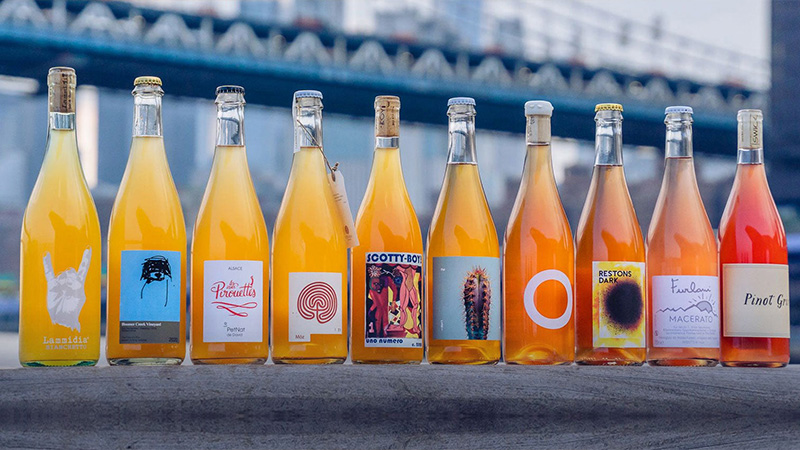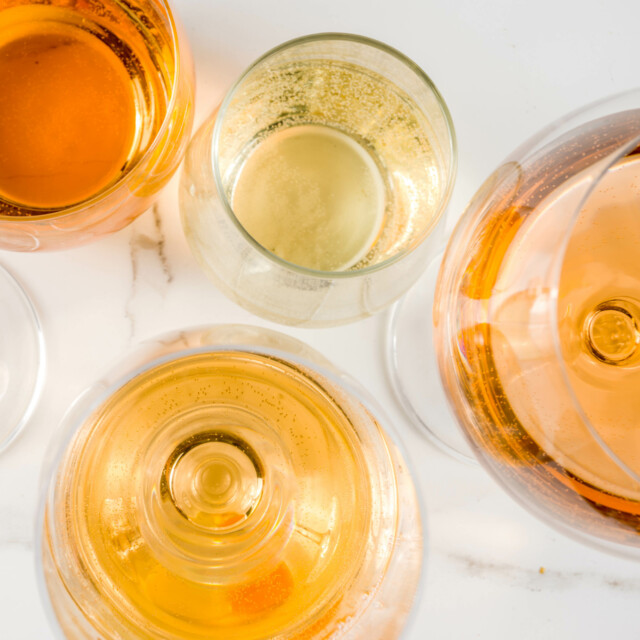Lately, I’ve been trying not to call orange wine “funky.” Mostly because the term is hackneyed to the point of being exhausted, but also because it’s often wrong.
While “funky” can signal mustiness or a perceived unpleasantness, it can also become trite and overused, ascribed to any wine that doesn’t conform to a certain conventional standard. And since its firecracker entrance into the American wine market, orange wine has been funkified within an inch of its life. It has been painted broadly, as strange and new, when it is in fact a style much older than most well-known, Old World varietals like Riesling or Syrah.
Orange wine originated in Georgia, where wine has been made for more than 8,000 years. Production began along the cloud-cast peaks of the Caucasus Mountains in fortress-like monasteries, where Assyrian monks loaded crushed grapes — skin, stems, and all — into giant clay pots called qvevri, which were buried in the ground for temperature control. This type of practice spread throughout eastern Georgia and was quickly adopted by family farms all over the country’s Kakheti province, a lush agricultural mecca flanked by two soil-nourishing river basins.
The country’s winemaking tradition remained unchanged until 1921, when Russia’s Red Army usurped Georgia, mechanizing its centuries-crafted wine production for the sake of volume over quality. When Georgia finally began to restore this tradition in the early to mid-1990s, Fertile Crescent countries like Slovenia, Croatia, and even Italy’s Friuli region followed suit, reviving their own long-buried vinicultural traditions.
“Slovenian and Friulian winemakers were inspired by Georgia because they had gone through something similar,” says Alexis Percival, managing partner of New York City wine destinations Ruffian and Kindred. “A lot of these people who were making very commercial, large-scale, and clean — what we would now call conventional — wine saw an opportunity to reclaim their cultures. They were looking to Georgia and saying, ‘Oh wow, this is really fascinating, this is like what my grandfather or my great-grandfather used to make,’ so they were inspired by something that they had in common.”

This “old man wine,” as it’s known in Croatia, came to be due to an abundance of thick-skinned grapes and a preservational approach to leaving them unpeeled, a process that can be incredibly arduous to do by hand, and also takes away from a wine’s shelf life.
“When you’re macerating a white wine with its skins, you’re offering it protection and longevity,” says Percival. “You’re taking tannins to preserve the wine, which makes sense if you don’t have modern filtration and chilling.”
Despite the protective benefits of skin-on maceration, skin-contact wine eventually fell out of fashion with the rise in popularity of pale-yellow and kiwi-green wines of France and Germany. With the onset of refrigeration in 1834, the crisp, chilled white became a mainstay in Parisian cabarets and, eventually, a global commodity. By the 20th century, the hand-picked, low-intervention approach to winemaking became more closely scrutinized under Soviet rule, with political pressure to implement more conventional methods of mass production.
In places like Georgia, though, white wine never stopped being orange. “The twin forces of history and fashion combine to create a remarkable tension around orange wines,” writes Eric Asimov in a recent New York Times article. Asimov means that, ironically, orange wine’s cultural significance has only intensified in places like Georgia and Slovenia, while elsewhere, it’s beginning to be discounted as trendy or capricious.
“It’s now becoming like the Lululemon of wines,” says Sarah Pierre, owner of 3 Parks Wine Shop in Atlanta. “Everyone is trying to wow their palates — that’s 100 percent been happening in the last four or so years. They’re using all these buzzwords like ‘funky’ or ‘dirty’ because that’s how these wines have been sold to them.”
For Doreen Winkler, a German-born sommelier and owner of Orange Glou, leaning into this marketing tactic seems to have worked. “I just didn’t see enough orange wine in other wine shops,” says Winkler. “All my friends told me that they’d usually see about two to three at a shop and that’s it, so a lot of people were asking me for it.” Winkler launched an orange wine subscription program in 2019, and her New York City storefront, which offers exclusively skin-contact bottles, opened its doors just last year.
Her approach is arguably one that mirrors one of the follies of the wine market itself — fostering awareness of a long forgotten form of winemaking by perpetuating a fad. Still, the demand for orange wines is undeniable. Pierre recalls the height of the rosé boom, when the pinkish-colored wine carved out its own section on wine lists. “We had about 40 different rosés on our shelves and now we have about 20,” she says, adding that several years ago, 3 Parks sold more rosé than any other wine shop in Atlanta. “But now we sell significantly more skin contact than we do rosé — significantly more.”
Over the past 15 years or so, orange and amber wines have emerged alongside natural wines as totems of a changing wine market, one that abides by a “what’s-old-is-new” ethos. For vibrantly hued wines of ancient origin, this means a resurrection of sorts — one that allows the consumer to engage with history and tradition, but at the same time, doesn’t.
“I think that what happened — and this is just my take and why we’re talking about it — is that New World winemakers who started experimenting with orange wines were already natural winemakers to begin with,” says Percival, who has worked with these types of wines since they first blew up on the American market. “So you have this conflation of natty wines with orange wines ’cause they usually go hand in hand, there’s an overlap, but if you tasted these producers’ red wines, they would probably be pretty weird too.”
When it comes to tasting notes, “funky” can be surprisingly limiting. “A lot of these amber wines can have nori or seaweed-like qualities or fish sauce if they’re aged — you get all these things that you’re not expecting in your glass,” she adds. It’s a profile that Percival, along with most wine professionals, would consider “challenging” rather than “funky,” a word that’s more so associated with a bad ferment.
“We want to compartmentalize something that probably wasn’t hyper compartmentalized for the greater part of history,”says Percival, “so we can only speak to our most recent history and our most recent memories.” In the case of orange wine, this compartmentalization leads not only to erasure, but a conflation with natural wine overall, nurturing a public opinion in which skin-contact wine becomes the most natural of natural wines.
I first came to the question of orange wine’s reductive treatment while working at a little Italian restaurant in Brooklyn. We ran a fairly extensive wine program of weekend crowd-pleasers, Italian old vines, and an amorphous collection of lesser-known varietals — which were, admittedly, more geared toward staff than our average guest. Over time, though, as wine drinkers looked to challenge their palates instead of placate them, these unusual and often rare allocations became more sought after.
The orange-curious would arrive in droves, clamoring for something golden-colored, pleading for whatever was “funkiest,” exclaiming to their neighbor, “It’s this new thing called orange wine,” incorrectly attributing novelty. I wanted to tell them that maybe “funk” wasn’t exactly what they were looking for, and that — as with spicy or sour food — it functioned within degrees. But this was hospitality — and you can’t just aggressively correct customers when you’re working for tips.
D.C. sommelier Erica Christian seems to have found a solution to integrating this type of education. “You want to place it [wine] in people’s lives in a way that they can relate to,” says Christian, who hosts Empowering the Diner, a series of wine-based events centered on BIPOC perspectives. “I feel that, as somms and wine professionals, it’s our job to make the best decision for people in terms of their palate and what they’re looking for, and what they want to explore. I think that if we just held exploration in higher regard when talking about wine, we would see a lot less of this mentality of orange wine as funky, orange wine equals natural wine, orange wine as the wine right now.”
When I share with Christian my orange wine conundrum, that the wine’s rich history seems to have been eclipsed by its Instagrammability, she points to a broader issue with the U.S. wine market. “You’re not going to explore wines from the Fertile Crescent at your local grocery store,” she says. “You’re not getting that abundance of opportunity to explore wine beyond French, Italian, German, so I really think that, ultimately, it all boils down to capitalism — this reliance on mass production — leading to an erasure of history.”
It almost makes sense, then, that many of the more old-school producers responsible for the renaissance of these wines — winemakers like Josko Gravner and Radikon in northeast Italy, Zidarich and Kabaj in Slovenia, and Alaverdi Monastery in Georgia — have been elevated to a level of austerity among low-intervention wine enthusiasts. “They resonate not just because they are so good qualitatively,” writes Asimov, “but also because, in their reckoning with centuries of history and conflict, they speak powerfully, both emotionally and intellectually.”
At the end of the day, it’s not the eradication of orange wine fever that wine professionals are seeking, but rather an acknowledgement of wine’s roots, its identity as a cultivated crop, a vine-strung emblem of ancient history that just keeps growing and growing so long as you let it. “I always say this, but fermentation is one of the most natural processes in the world,” says Christian. “It’s the process of fruit falling from the vine or the tree or the truck, whatever it is, and hitting the ground and giving back to the same thing that grew it.” What is natural or orange anyway besides just letting something be?
If wine is, above all, a fruit for harvest, then maybe we should treat it like such. We should admire its harlequin growth, its variegated colors. Perhaps, then, eliminating “funky” is only part of the answer. Perhaps the real answer is a total embrace of wine in all its carrot, coral, and titian-colored splendor — as an agricultural marvel, an amalgam of history and hue.
